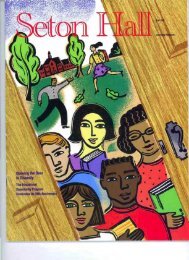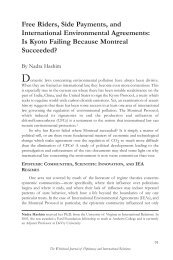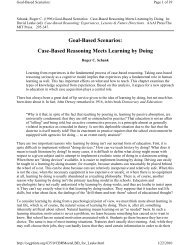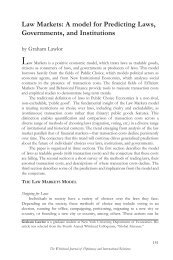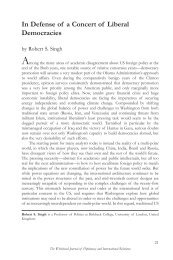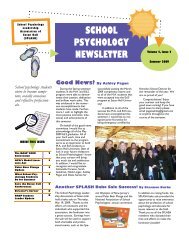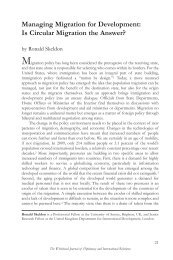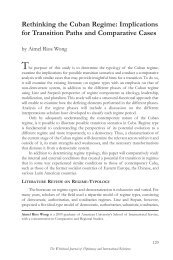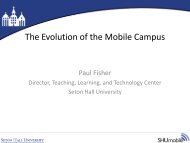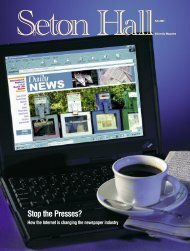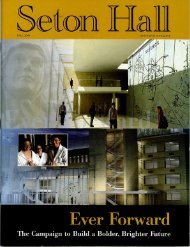Seton Hall Magazine, Winter 2000 - Seton Hall University
Seton Hall Magazine, Winter 2000 - Seton Hall University
Seton Hall Magazine, Winter 2000 - Seton Hall University
You also want an ePaper? Increase the reach of your titles
YUMPU automatically turns print PDFs into web optimized ePapers that Google loves.
A r t<br />
As we look back on the different<br />
art movements and interpretive<br />
approaches that have taken<br />
place since the early 1900s, it is hard<br />
to imagine what the 21st century will<br />
reveal. Within the past hundred years,<br />
the art museum has seen a dramatic<br />
change in the way it interprets and communicates<br />
its collections. The growth of<br />
cultural diversity as an important issue<br />
within the community has led many<br />
museums to begin reconsidering their<br />
approaches to both permanent and temporary<br />
exhibitions. As they reexamine<br />
their interpretive method to installations<br />
within the context of a multicultural and<br />
pluralistic society, museums are recognizing<br />
the need for innovative educational<br />
programs that embrace the diversity<br />
of the community.<br />
The relationship between the museum<br />
and the audience is a complex web<br />
of personal identities, histories, beliefs<br />
and values. Within this framework,<br />
museum education has become crucial<br />
to the effort of establishing a museum<br />
policy for the 21st century. Where education<br />
has long been seen as secondary<br />
within the museum identity, it is now a<br />
central focus in developing community<br />
relations. Museums have recognized that<br />
the ways in which works of art can be<br />
interpreted and appreciated are as varied<br />
as the cultures and ideas the works of art<br />
represent. Several museums have undertaken<br />
projects and surveys that examine<br />
labels, language, installation techniques<br />
and museum audiences. But few have<br />
combined this information as a means to<br />
encourage visitors to make connections<br />
across entire collections and cultures.<br />
Even fewer have developed comprehensive<br />
interpretive programs that engage<br />
the viewer in the basic concepts and elements<br />
within works of art.<br />
In the early part of the 20th century,<br />
museum curators began to develop educational<br />
programs that emphasized form<br />
and content, but failed to explain the<br />
24 SETON HALL UNIVERSITY MAGAZINE<br />
Guiding the Audience to<br />
Discoveries that Embrace Diversity<br />
BY TRACY MELILLO, M.A. ’96<br />
basic ideas and vocabulary that compose<br />
a work of art. Those elements common<br />
to all visual arts are line, form, color,<br />
space and distance. It was not until the<br />
1940s that the Gallery of Art Interpretation,<br />
the first permanent interpretive<br />
space created for adults within<br />
a museum, was established at the Art<br />
Institute of Chicago. These gallery presentations,<br />
done in conjunction with<br />
a major exhibit in the museum and<br />
focusing on an area of visual perception<br />
that most individuals were not<br />
aware of when viewing works of art,<br />
were so successful that gallery schedules<br />
were often extended to accommodate<br />
the visitor demand.<br />
Although more pluralistic thinking<br />
has superseded these formalist methods,<br />
the approach is still clearly relevant<br />
today. With the knowledge of basic<br />
artistic concepts, museum audiences are<br />
given the tools to approach a work of art<br />
and expand their understanding of different<br />
cultures and historical periods.<br />
When educators provide a strong foundation<br />
for their audience, museum programs<br />
can then lead the viewer to make<br />
comparisons about the role of art in our<br />
changing world. Within the walls of the<br />
museum, politics, religion and philosophy<br />
are intertwined through the art of<br />
“Within the walls<br />
of the museum,<br />
politics, religion<br />
and philosophy<br />
are intertwined<br />
through the art<br />
of the day, creating<br />
a mirror of the<br />
times.”<br />
the day, creating a mirror of the times.<br />
It is the museum educator’s role to create<br />
an accessible environment for all to<br />
approach and come away with an understanding<br />
of what has shaped our collective<br />
identity.<br />
I would like to see museums of the<br />
21st century expand their interpretation<br />
of the objects within their collections<br />
and draw more cross-cultural comparisons<br />
to reveal the diversity of each culture<br />
and its own unique contribution to<br />
the arts. The involvement of community<br />
leaders, scholars, educators and local citizens<br />
is essential in shaping the content<br />
and direction of museum programs<br />
surrounding exhibitions. By doing<br />
so, museums are recognizing that the<br />
audience is an active creator of its own<br />
meaning, an interpreter who brings<br />
its own heritage, beliefs and cultural<br />
awareness in understanding and<br />
responding to works of art. It is within<br />
this context that the greatest opportunity<br />
for discovery is possible for the<br />
museum of the millennium.<br />
Tracy Melillo, M.A. ’96, is manager of title<br />
administration and production at Random<br />
House Publishers in New York City.



